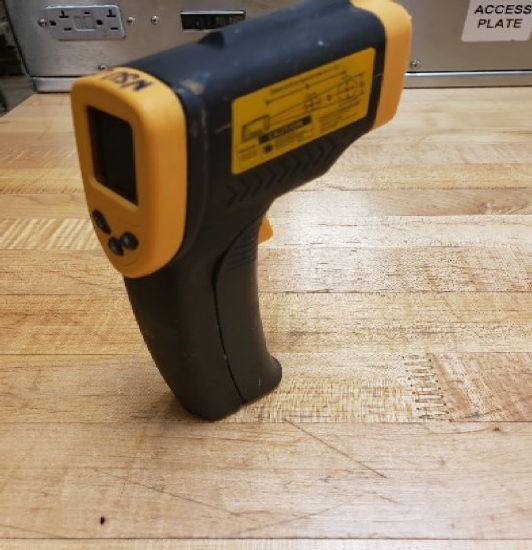1.1: Baking and Pastry Equipment
- Page ID
- 21171
\( \newcommand{\vecs}[1]{\overset { \scriptstyle \rightharpoonup} {\mathbf{#1}} } \)
\( \newcommand{\vecd}[1]{\overset{-\!-\!\rightharpoonup}{\vphantom{a}\smash {#1}}} \)
\( \newcommand{\id}{\mathrm{id}}\) \( \newcommand{\Span}{\mathrm{span}}\)
( \newcommand{\kernel}{\mathrm{null}\,}\) \( \newcommand{\range}{\mathrm{range}\,}\)
\( \newcommand{\RealPart}{\mathrm{Re}}\) \( \newcommand{\ImaginaryPart}{\mathrm{Im}}\)
\( \newcommand{\Argument}{\mathrm{Arg}}\) \( \newcommand{\norm}[1]{\| #1 \|}\)
\( \newcommand{\inner}[2]{\langle #1, #2 \rangle}\)
\( \newcommand{\Span}{\mathrm{span}}\)
\( \newcommand{\id}{\mathrm{id}}\)
\( \newcommand{\Span}{\mathrm{span}}\)
\( \newcommand{\kernel}{\mathrm{null}\,}\)
\( \newcommand{\range}{\mathrm{range}\,}\)
\( \newcommand{\RealPart}{\mathrm{Re}}\)
\( \newcommand{\ImaginaryPart}{\mathrm{Im}}\)
\( \newcommand{\Argument}{\mathrm{Arg}}\)
\( \newcommand{\norm}[1]{\| #1 \|}\)
\( \newcommand{\inner}[2]{\langle #1, #2 \rangle}\)
\( \newcommand{\Span}{\mathrm{span}}\) \( \newcommand{\AA}{\unicode[.8,0]{x212B}}\)
\( \newcommand{\vectorA}[1]{\vec{#1}} % arrow\)
\( \newcommand{\vectorAt}[1]{\vec{\text{#1}}} % arrow\)
\( \newcommand{\vectorB}[1]{\overset { \scriptstyle \rightharpoonup} {\mathbf{#1}} } \)
\( \newcommand{\vectorC}[1]{\textbf{#1}} \)
\( \newcommand{\vectorD}[1]{\overrightarrow{#1}} \)
\( \newcommand{\vectorDt}[1]{\overrightarrow{\text{#1}}} \)
\( \newcommand{\vectE}[1]{\overset{-\!-\!\rightharpoonup}{\vphantom{a}\smash{\mathbf {#1}}}} \)
\( \newcommand{\vecs}[1]{\overset { \scriptstyle \rightharpoonup} {\mathbf{#1}} } \)
\( \newcommand{\vecd}[1]{\overset{-\!-\!\rightharpoonup}{\vphantom{a}\smash {#1}}} \)
\(\newcommand{\avec}{\mathbf a}\) \(\newcommand{\bvec}{\mathbf b}\) \(\newcommand{\cvec}{\mathbf c}\) \(\newcommand{\dvec}{\mathbf d}\) \(\newcommand{\dtil}{\widetilde{\mathbf d}}\) \(\newcommand{\evec}{\mathbf e}\) \(\newcommand{\fvec}{\mathbf f}\) \(\newcommand{\nvec}{\mathbf n}\) \(\newcommand{\pvec}{\mathbf p}\) \(\newcommand{\qvec}{\mathbf q}\) \(\newcommand{\svec}{\mathbf s}\) \(\newcommand{\tvec}{\mathbf t}\) \(\newcommand{\uvec}{\mathbf u}\) \(\newcommand{\vvec}{\mathbf v}\) \(\newcommand{\wvec}{\mathbf w}\) \(\newcommand{\xvec}{\mathbf x}\) \(\newcommand{\yvec}{\mathbf y}\) \(\newcommand{\zvec}{\mathbf z}\) \(\newcommand{\rvec}{\mathbf r}\) \(\newcommand{\mvec}{\mathbf m}\) \(\newcommand{\zerovec}{\mathbf 0}\) \(\newcommand{\onevec}{\mathbf 1}\) \(\newcommand{\real}{\mathbb R}\) \(\newcommand{\twovec}[2]{\left[\begin{array}{r}#1 \\ #2 \end{array}\right]}\) \(\newcommand{\ctwovec}[2]{\left[\begin{array}{c}#1 \\ #2 \end{array}\right]}\) \(\newcommand{\threevec}[3]{\left[\begin{array}{r}#1 \\ #2 \\ #3 \end{array}\right]}\) \(\newcommand{\cthreevec}[3]{\left[\begin{array}{c}#1 \\ #2 \\ #3 \end{array}\right]}\) \(\newcommand{\fourvec}[4]{\left[\begin{array}{r}#1 \\ #2 \\ #3 \\ #4 \end{array}\right]}\) \(\newcommand{\cfourvec}[4]{\left[\begin{array}{c}#1 \\ #2 \\ #3 \\ #4 \end{array}\right]}\) \(\newcommand{\fivevec}[5]{\left[\begin{array}{r}#1 \\ #2 \\ #3 \\ #4 \\ #5 \\ \end{array}\right]}\) \(\newcommand{\cfivevec}[5]{\left[\begin{array}{c}#1 \\ #2 \\ #3 \\ #4 \\ #5 \\ \end{array}\right]}\) \(\newcommand{\mattwo}[4]{\left[\begin{array}{rr}#1 \amp #2 \\ #3 \amp #4 \\ \end{array}\right]}\) \(\newcommand{\laspan}[1]{\text{Span}\{#1\}}\) \(\newcommand{\bcal}{\cal B}\) \(\newcommand{\ccal}{\cal C}\) \(\newcommand{\scal}{\cal S}\) \(\newcommand{\wcal}{\cal W}\) \(\newcommand{\ecal}{\cal E}\) \(\newcommand{\coords}[2]{\left\{#1\right\}_{#2}}\) \(\newcommand{\gray}[1]{\color{gray}{#1}}\) \(\newcommand{\lgray}[1]{\color{lightgray}{#1}}\) \(\newcommand{\rank}{\operatorname{rank}}\) \(\newcommand{\row}{\text{Row}}\) \(\newcommand{\col}{\text{Col}}\) \(\renewcommand{\row}{\text{Row}}\) \(\newcommand{\nul}{\text{Nul}}\) \(\newcommand{\var}{\text{Var}}\) \(\newcommand{\corr}{\text{corr}}\) \(\newcommand{\len}[1]{\left|#1\right|}\) \(\newcommand{\bbar}{\overline{\bvec}}\) \(\newcommand{\bhat}{\widehat{\bvec}}\) \(\newcommand{\bperp}{\bvec^\perp}\) \(\newcommand{\xhat}{\widehat{\xvec}}\) \(\newcommand{\vhat}{\widehat{\vvec}}\) \(\newcommand{\uhat}{\widehat{\uvec}}\) \(\newcommand{\what}{\widehat{\wvec}}\) \(\newcommand{\Sighat}{\widehat{\Sigma}}\) \(\newcommand{\lt}{<}\) \(\newcommand{\gt}{>}\) \(\newcommand{\amp}{&}\) \(\definecolor{fillinmathshade}{gray}{0.9}\)The kitchen is filled with the tools that help a Pastry Chef create wonderful creations. The key is in the mastering of these tools to perform that task they are meant for. As with anything, practice is the key to becoming proficient in any task and in the kitchen, the mastering of the tools is essential. Each tool is designed to perform a task. In order to master task the Pastry Chef need to understand the equipment and what each piece is used for. A keen understanding of the workings of the equipment is also important for the finished product to be its best.
Stand Mixers
Commercial mixers are a big part of the commercial kitchen. They aid in making the mixing of ingredients easier and faster. While small batches of certain doughs can be mixed by hand there are many times when it is more beneficial in the interest of time to use.
Tabletop mixers: In the kitchen, the tabletop mixers are used for small soft batches of dough. This one can be easily moved. The attachments for this mixer include a dough hook, balloon whip, and paddle.
The mixer has three speeds. The “1” is the slowest and what is used to begin the mixing process. Once the ingredients combine then the mix can be moved to “2” medium and then to “3” high.
The front of the mixer has a small metal disk and black pin. This would allow for the use of other attachments.
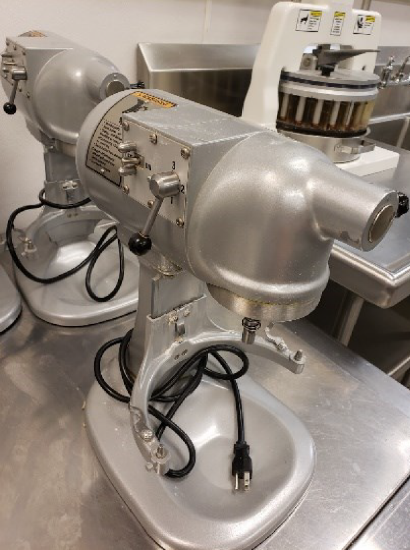
Table Top Mixer
This mixer is larger than the stand mixer. The mixers vary in size depending on the kitchen / bakeshop that they are being used in most professional kitchens will have the 20 quart tabletop mixer seen the picture. The tabletop mixers sizes range from five to 20 quarts. The size is determined by the amount of product the bowl of the mixer can hold. The front is also allows for attachments that will allow for meat grinding and pasta cutting.
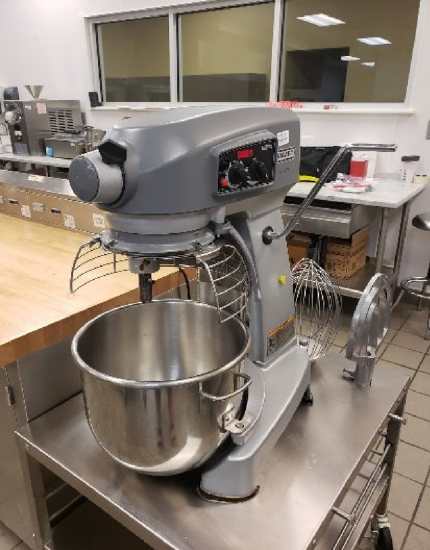
Both stand and tabletop mixers come with 3 different attachments.
Balloon Whip (a1)
The balloon whip is used to whisk air into ingredients. The whip is used for soft ingredients like heavy cream, meringues, and mousses.
Paddle (a2)
The paddle attachment is used to cream ingredients together or alone. Ingredients that are too hard for the whip to break down such as butter and cream cheese. It is also used for many batters that begin with the creaming method.
Dough Hook (a3)
This is used to mix doughs.
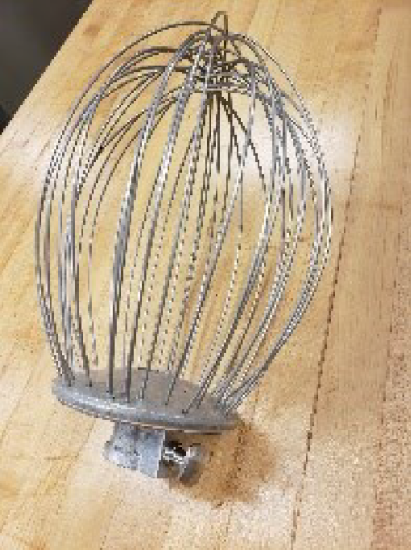
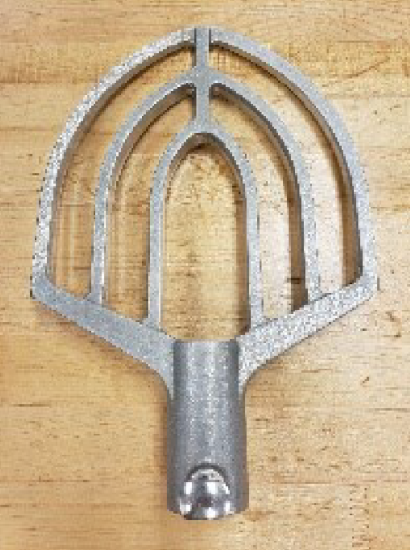
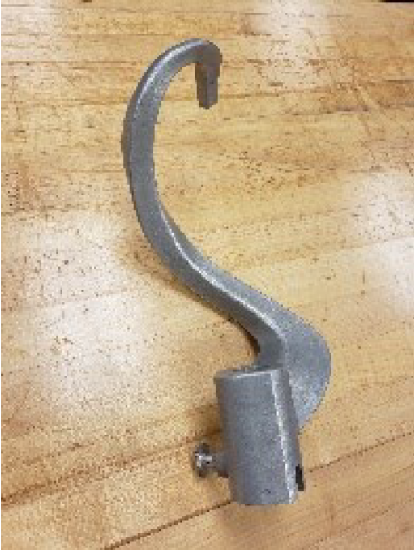
a1 a2 a3
Courtesy of Tammy Rink
Chef Instructor Chef John Folse Culinary Institute
Dough Cutters
Dough cutters are used to quickly and efficiently cut large amounts of dough into the required size. The dough cutter pictured is the Dutchess cutter. This cutter has the cutter surface that will cut 36 equal portions at once.
The dough is placed in the metal holding tray. The tray is returned to the Dutchess with the metal handle pointing outwards. The long handle is then pulled toward the front of the press. This allows for the dough to be tamped down and to assure that the dough covers the entire cutting surface. With the handle pressed down, the cut lever is released and the cutters are exposed to cut the dough. The handle is then raised, and the dough is left in 36 pieces. This tabletop version does not have a rounder. The dough for cutting will be made up according to specifications of the pastry chef.
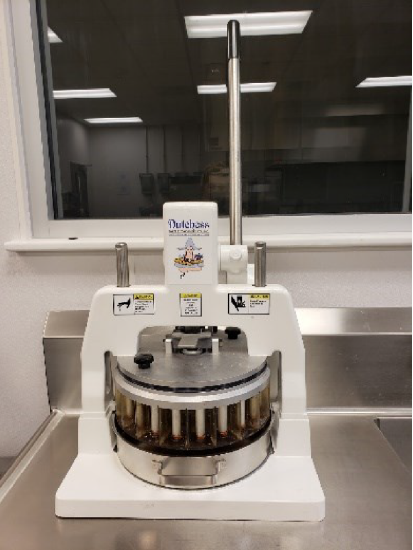
| Size needed | Amount of Dough | Used for |
|---|---|---|
| 1.2 oz. each (35 to 40 grams) | 1.2 x 36 = 43.2 /16 = 2.7 lbs. | Bistro Dinner Rolls |
| .98 oz. each (28 grams) | .98x36=35.28 /16 = 2.20 lbs. | Russian Service Rolls |
Dough Sheeter
Sheeters come in various sizes like other equipment. The type that is in your shop will depend on the space you have and what it is needed for. There are tabletop sheeters and standalone sheeters. The sheeter is used to quickly and uniformly, roll out dough to a desired thickness. The operator runs the sheet by decreasing the space between the rollers as the dough passes through them. The tabletop is done by feeding the dough through the rollers by hand.
Proofer
The proof box or proofing cabinet keeps a controlled heat and humidity that allows yeast doughs to finish its final rise before the baking process. The box operates by adding water to the well at the bottom that has a heating element in it.
Control settings allow the user to change the temperature and humidity for different types of bread dough.
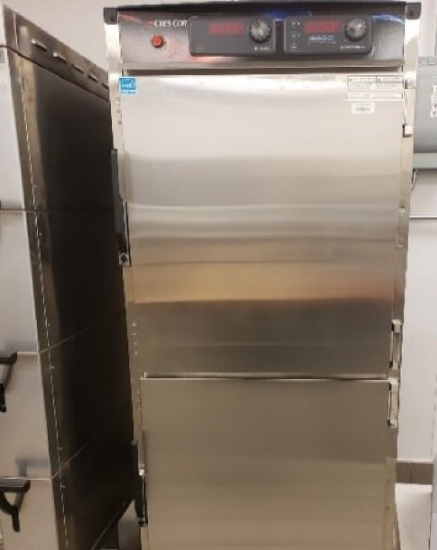
Deck Oven
The four deck ovens are stacked into a single piece of equipment. They used conduction heat to bake products. The heat travels to the stone bottom of the oven (the baking surface) and then to the bread placed directly on the stone or the pan. The secondary heat source is radiant heat that penetrates the dough to assist in baking the bread. Deck ovens are necessary have for the artisan bread baker. They allow for the beautiful, crust bread loaves.
Deck ovens also have the option to inject steam, which aids in the formation of the crust. Each deck can be set at different temperatures, which allows for many different types of baked goods to be cooked at once.
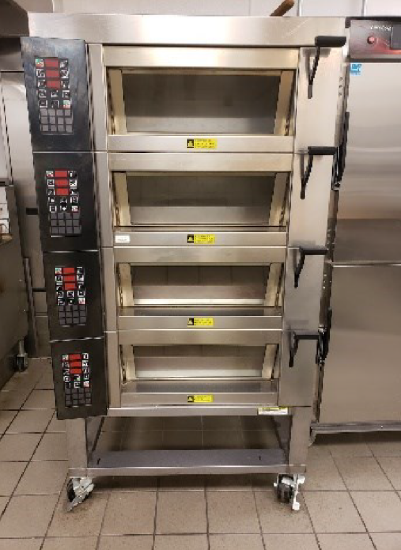
Convection Oven
The stacked convection ovens are a great and versatile oven. What makes this oven a fantastic addition to a commercial kitchen is the range of heat that the oven can produce. The oven heats by fan forced heat, which gives an even heating source.
From drying out meringues to baking of breads the convection oven is the perfect oven for the task. This oven also allows for the addition of steam, which is important to give, rolls a shiny finish and the full rise of the bread dough.
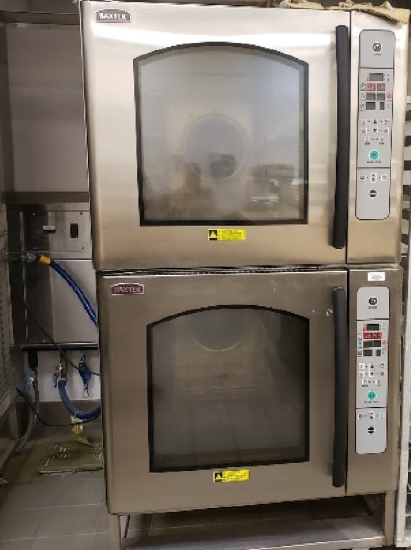
Fryer
The double basket fryer is a gas heated fryer. Each fryer section allows for independent frying. The oil in each section is kept separated by a divider and thus allows for different foods to be fried without contamination of the oil.
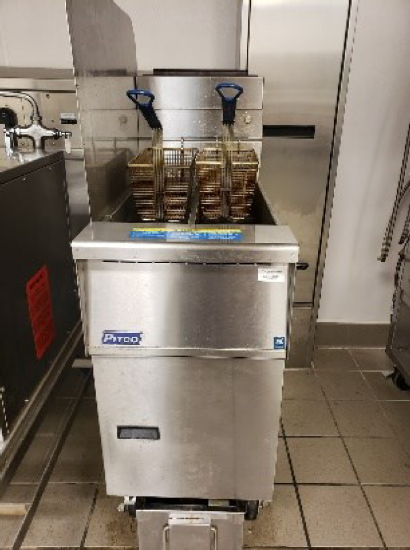
Stove
The 6-burner gas stovetop allows commercial style cooking with a high BTU output. The range also has a storage cabinet. The locking wheels aid in keeping it in place while also allowing it to be moved for cleaning purposes. There is also a catch tray for any spills or overflows.
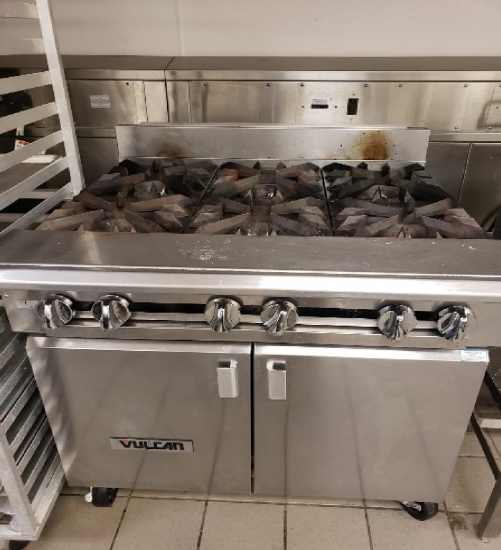
Ice Cream Machine
The Taylor ice cream machine is designed to turn your base into either soft serve ice cream or sorbet. The commercial machine adds just the right amount of overrun (air) to the mix to give you a smooth, creamy dessert.
The timer is set to the amount of spin time. The auto button is turned on that the machine automatically counts down the minutes of spin time. The blade inside the machine spins incorporating the air into the mix as well as scraping the barrel to assure an even smooth mix.
When the timer is done, the buzzer will go off. If the mix is at the desired texture, the extrude button is pressed and the machine will be expelled through the hopper (white knob).
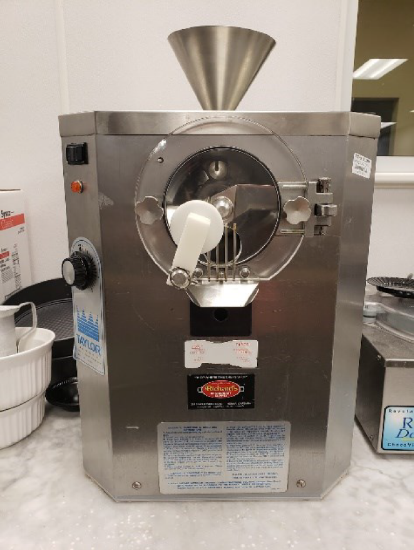
Hand Held Kitchen Equipment
Spatula
Rubber spatulas are heat resistant. This means that they will not transfer heat or get hot when using while cooking. They will melt if left over a fire. They come in different sizes. Pictured are the small and large rubber spatulas.
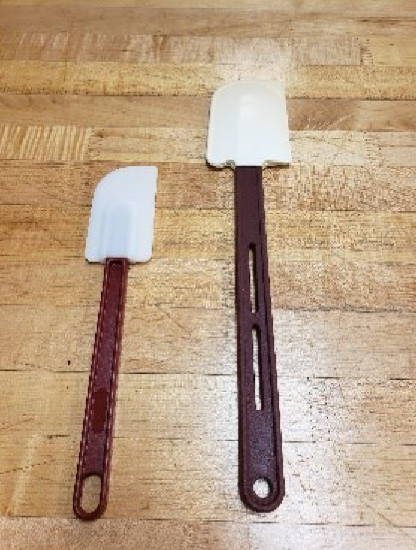
Cake Spatulas (palette knife) these are metal spatulas that are used for cake decorating. They range in size from small to large. The size of the blade will determine which one you use. Each has a different feel in your hand.
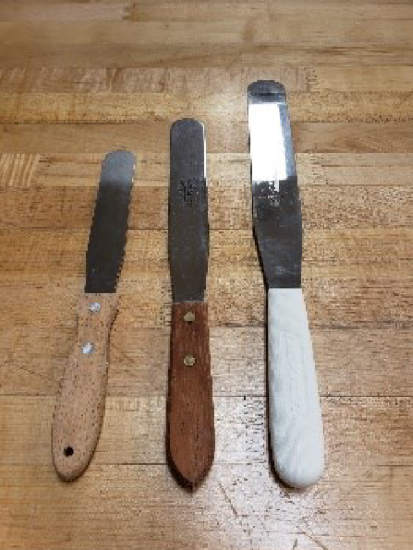
Offset metal spatulas are used in cake decorating. The blade of the spatula is uneven which allows the user to spread batter in pans easily. Just like the cake spatula, they come in different sizes.
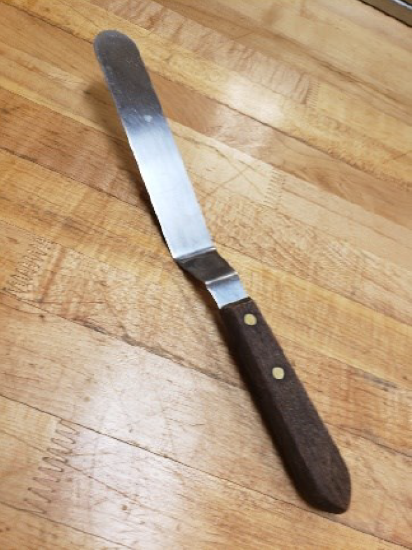
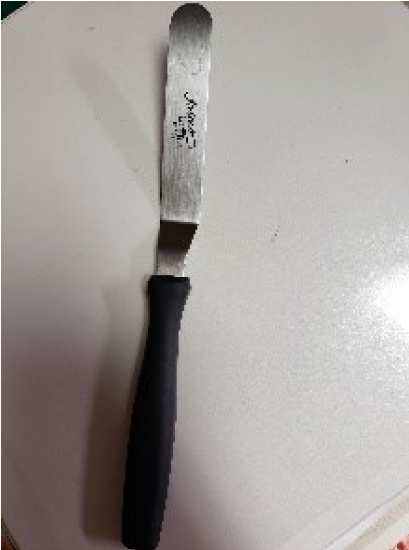
Miscellaneous Kitchen Tools
Bench Scraper
These are used to clean off the bench. The metal blade is hard and allows scraping dough that is stuck to the bench easily without cutting grooves into the wooden bench top. They are also used to cut dough evenly and quickly.
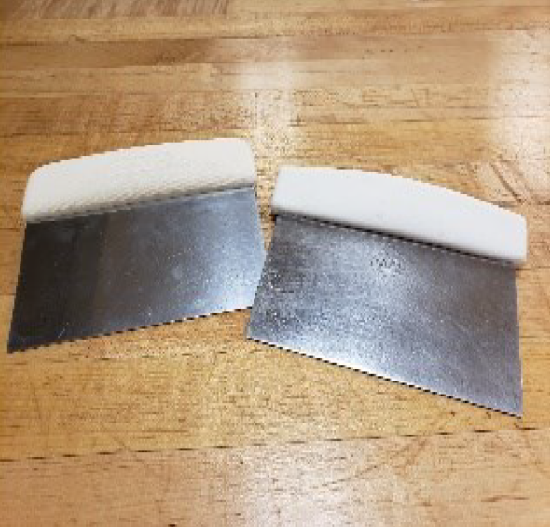
Pastry Brush
The pastry brush has a variety of uses. For cake decorating a dry brush is used to remove crumbs from the turntable and cake. It can also be used to add cake syrup to cake layers. When adding egg wash to doughs the brush allows for even application.
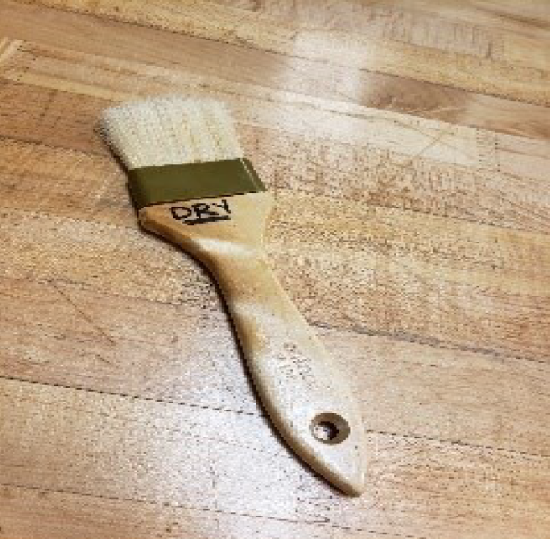
Cake Comb
This tool is used in decorating cakes. There are many different decorative types. They are used to add dimension to the sides of cakes by applying pressure to the comb as you turn the cake. The design left depends on the decorator and the comb used.
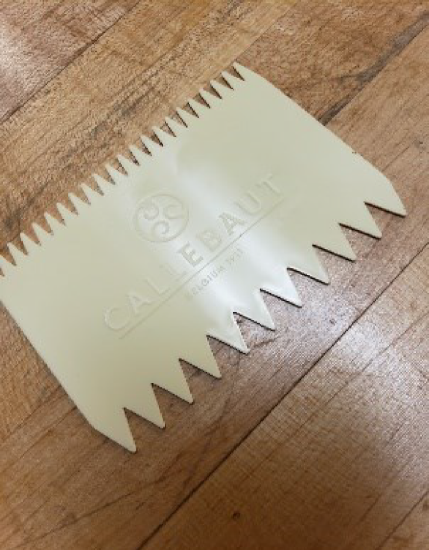
Courtesy of Chef Tammy Rink
Measuring Spoons
The measuring spoons are nested in a set. The set consist of 1 Tablespoon, 1 Teaspoon. ½ Teaspoon, ⅓ Teaspoon and ¼ Teaspoon. When measuring dry ingredients: scoop the spoon into the ingredients, using a straight edge scrape the top of the of the spoon to get an even amount.
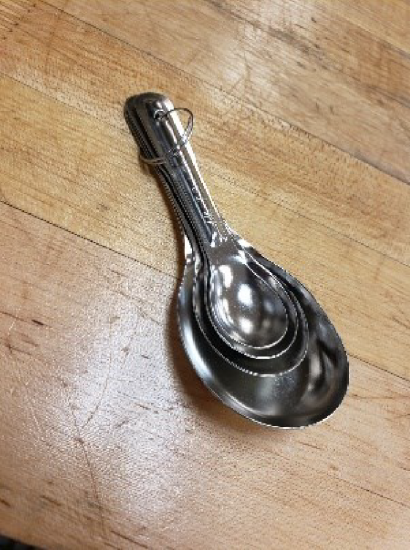
Measuring Cups
The nested measuring cups are used for measuring dry ingredients. The amounts of each cup is printed on the inside bottom. The measurements are 1 cup, ½ cup, ⅓ cup and ¼ cup.
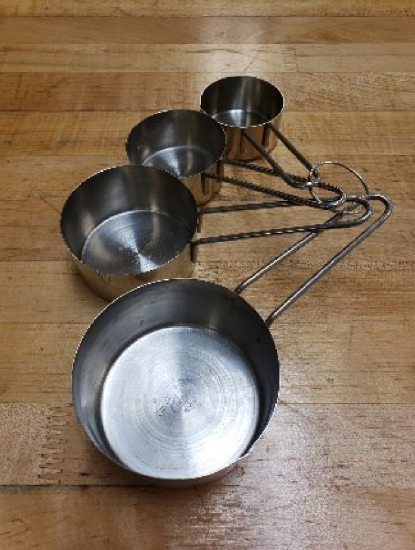
Metal Spoons
They come in slotted and un-slotted spoons. They are used in cooking dishes. They are excellent conductors of heat. If left in a pot over heat they will become very hot and will burn someone. Slotted will allow the liquid to drain through.
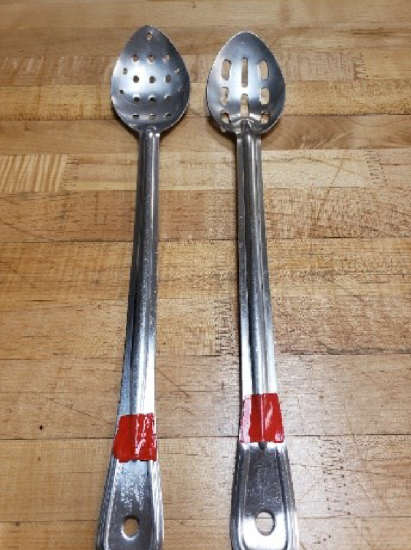
Tongs
These are used to handle hot food or ready to eat food.
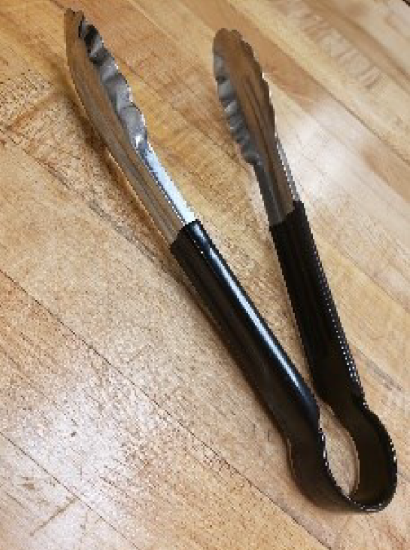
Ladles
These come in various sizes. They are measured by ounces. When tempering hot liquids these are used
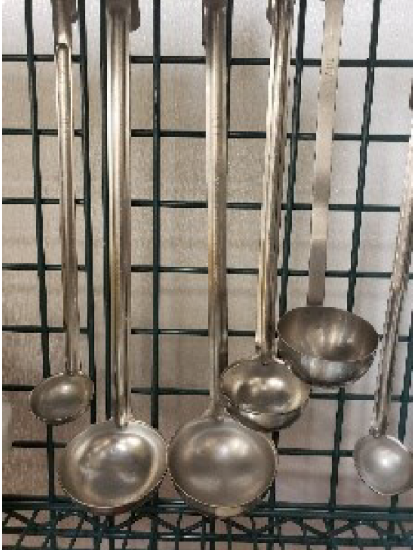
Peelers
Used to peel fruits and vegetables. The blade on this is very sharp. Most peelers have a pointed end to remove blemishes on fruit and vegetables.
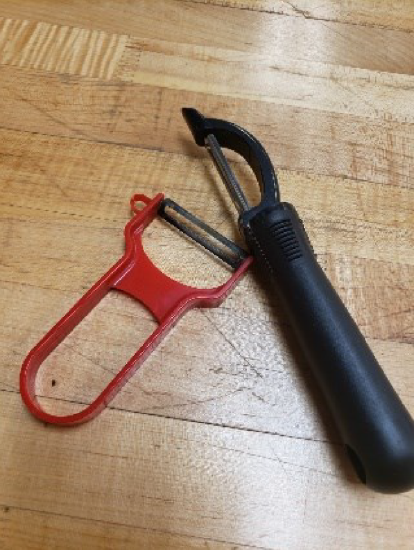
Micropane
Small hand held graters used to zest fruits and shred hard cheese and other ingredients. The zest from fruits are in tiny pieces rather than long slivers.
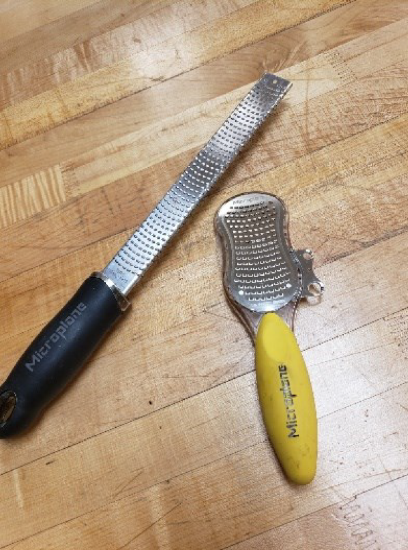
Thermometer
Thermometers are used to find the correct temperature of items. When cooking, they can find the internal temperature of meat, and bread – useful information. The thermometer pictured is an infrared thermometer. These find the surface temperature of items. They are good when tempering chocolate. Types: pocket, candy, infrared. They come in both digital and dial.
